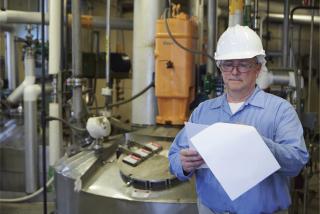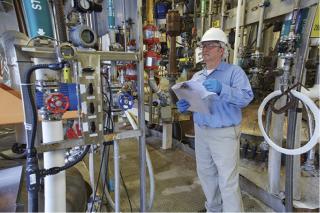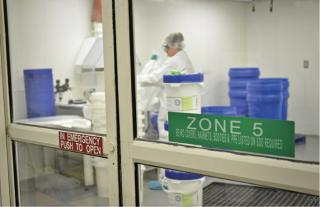The Benefits of Embedding Safety in Lean PracticesThe Benefits of Embedding Safety in Lean Practices
May 1, 2014
The concept of “lean thinking” is applied with increasing frequency in a number of industries, including biopharmaceutical manufacturing, to eliminate waste and optimize workflow. Lean thinking refers to focusing on standardizing processes within workplaces to minimize redundancies and improve value. Safety also is important to every workplace, especially in biopharmaceutical manufacturing because it uses process chemical ingredients. By embedding attention to safety into the practice of lean manufacturing, companies can improve employee buy-in of lean initiatives while reinforcing the importance of safe practices. This combined philosophy allows companies to improve both workplace safety and efficiency.
How Waste Affects Safety
Although safety and lean programs may seem to have disparate goals, the two are more intertwined than many people may think. The eight wastes targeted by lean initiatives are commonly identified as underused talent, waiting, defects, unnecessary movement, excessive product transportation, extra inventory, overprocessing, and overproduction. Each of those has a clear influence on safety impact.
By underusing talent available in your personnel, the opportunity is missed for those closest to a given task to contribute to conversations about identifying and reducing workplace hazards associated with it. Employees should be encouraged to actively participate in all aspects of lean and safety programs. Their experience leads to insight that managers or others who are removed from the process may not have.

Sustain your success by integrating safety inspections into other functional audits to increase frequency and improve hazard recognition across functions.
Waiting refers to wasted time. Poorly designed processes and workflow systems can cause delays, which wastes employees’ time and adversely affects their motivation. Those who are forced to rush to catch up have an increased risk of falling and overexerting themselves. Task design should balance the physical and mental capabilities of employees.
Lean manufacturing aims to eliminate defects in processes, particularly by preventing their occurrence. Prevention takes less time and involves fewer injury exposures than defect discovery and rework. Rework often is nonstandard work and has not been thoroughly analyzed for hazards. The need for rework and its related risks can be minimized by continuously striving to decrease workflow defects.
Unnecessary movements or motions (such as reaching for tools or bending to pick up heavy objects) increase the risk of injury. Improving workstation ergonomics reduces such risks. And designing a pharmaceutical manufacturing plant for efficient workflow reduces unnecessary movements.
Similarly, excessive product transportation increases opportunities for spills and leaks and subsequent slips and falls. Every manual movement of material increases risk of ergonomic injury. Lean initiatives reduce unnecessary movements of people and product, which improves safety and workflow.

In the long term, building safety into your lean process can help reduce the number of injuries in your plant, saving time and money.

The 5S methodology for safety-oriented lean practices includes standardized procedures and workflows to detect and prevent variation, as well as adaptive workstations to improve employee interfaces and meet the ergonomic needs of an interchangeable workforce.
Extra or unnecessary inventory (parts, chemicals, and product) increases the risk of injuries from handling. This also can lead to trip hazards and minimize space for safe exits from a building in an emergency.
Overprocessing product can lead to abnormal operating conditions and work-arounds in the process. This increases the risk of unidentified hazards that could cause injury.

Standard work begins with listing the detailed steps of each task in a process.

Lean safety visuals can include instructions on how to wear personal protective equipment.
Finally, overproduction leads to inventory being stored too long. That can mean potentially dangerous expiration of hazardous chemicals. Storing too much product can result in excess inventory stacks that can settle and shift or become unstable if stored for too long. Special storage locations (such for flammable items) are not often designed to handle excess inventory, thereby leading to improper storage of hazardous materials.
When you assess how the same wastes that lean manufacturing seeks to eliminate directly relate to safety and workplace hazards, it makes sense to consider embedding safety directly into a lean program. The first step toward success in combining these important concepts is getting employees who are directly involved in both initiatives on board with the process and its ultimate goals.
A Shared Vision
The need for employee buy-in is a simple but often overlooked key to success for every lean initiative. In addition to their normal workload responsibilities, employees or technicians in your manufacturing operations may be asked to participate in a number of other workplace programs such as education, certification, or training sessions. When a mandate for yet another initiative comes down from administration, it is often seen as just another item to add to the list — and not something employees view as having much value. But if you embed safety in your approach, employees will have a vested interest in the goals of the program. Instead of being just another item on the to-do list, lean operations have an added importance in employees’ jobs. Improving the safety and efficiency of routine tasks is the key to prompting buy-in and creating a shared vision of goals, which ultimately leads to program success.
To get employees on board with your integrated lean and safety programs, you need to actively seek their input about workflow challenges, safety hazards, and ideas for improvement. They are the people who are closest to the work. They know how each process is supposed to occur and, more important, what its workflow actually looks like. What work-arounds have been developed to meet needs? What are the hazards they see every day? In addition to pointing out safety risks that management may have missed, it is likely that employees also will have unique insight into how to mitigate risks and improve processes. When asked for their ideas and when involved in the process, employees feel valued and are vested in the final vision of a program.
Lean Tools
Many tools exist to help companies implement lean manufacturing, and safety can be incorporated into each one. These tools are diverse enough to satisfy a broad spectrum of requirements that your facility might face based on factors such as size, current processes, and available resources.
5S Methodology: Among the most common lean approaches, especially safety-oriented ones, is the 5S methodology: sort, set in order, shine, standardize, and sustain. Often seen as a basic starting point for lean manufacturing, the 5S approach can be considered a way to establish safety in the workplace. It is relatively easy to understand and train employees to use.
Sort involves going through inventory, tools, and materials in the plant and work area and removing unnecessary items. Storing only the materials required for each task at the point of use minimizes errors such as use of wrong ingredients.
Next, set in order. Organize items and processes in a logical, safe way. Consider safety elements such as ergonomics in addition to efficiency and waste-free workflow.
Shine, or systematic cleaning, involves inspecting and cleaning equipment and workspaces and keeping them clean. Use adequate lighting and mark locations where items should be stored. This is among the most important foundations for safe and efficient biopharmaceutical manufacturing. For example, to avoid clutter and mistakes, workstations should be designed to accept only the chemicals or materials that should be at each station.
Next, standardize procedures, workflows, and workstations to promote employee interchangeability. This allows a number of employees to perform the same task and minimizes the potential for errors and safety hazards.
Finally, sustain your success by integrating safety inspections into other functional audits to increase frequency and improve hazard recognition across functions. Disciplined adherence to procedures over time will result in a safer workplace and minimized waste.
With 5S, it's important to remember that the process is about more than just cleaning. A careful application of 5S focuses on designing work areas to facilitate smarter (and therefore safer) work. By thinking of it as only a cleaning process, you're missing out on the many potential benefits to be gained.
Standard work is an approach to lean manufacturing that refers to carefully documenting and regularly improving procedures. Standard work procedures should be routinely updated to eliminate waste. To incorporate safety, biopharmaceutical manufacturers can decide that part of each improvement step should reduce risk as well. This is the fundamental reason for embedding safety into your lean practices: If a process is improved, then it should also become safer.
A number of lean approaches can be applied through standard work. But at its heart, this approach begins with listing the detailed steps of each task in a process, including the amount of time each task takes to perform. Embed safety in standard work by assessing hazards associated with each step during creation of standard work and including the controls in place to manage risk. Often controls for managing risk are detailed in separate documents and not readily available on the shop floor where work is completed. That is the place to list ergonomic controls for performing a task, required personal protective equipment for handling hazardous chemicals, and special safety equipment for minimizing risk of injury. Sustaining this means revisiting documents and procedures regularly to improve processes and reduce associated risks.
Kaizen (a Japanese word meaning “good change) events are an essential lean tool. The approach refers to continuous improvement events designed to study each aspect of a process and improve it. The kaizen approach is a logical next step for plants that started with standard work. Now that your current best practices are carefully documented, you have a baseline for improvement that may take place through a kaizen event.
Embed safety in your kaizen events by considering safety when you look at each piece of a process and find ways to reduce risks. That kind of risk reduction or process improvement performed without safety embedded in the strategy can improve process efficiency but add new uncontrolled hazards from process redesigns. Approaching kaizen events with safety in mind combines the goals of process improvement and process safety.
Visual management traditionally has been an important tool for both safety and lean programs. This approach simply uses visual cues to inform and direct operator interface in a process or at a workstation. Those signs and tools should be designed to clearly describe how and what to do, while eliminating waste and risk. In biopharmaceutical manufacturing, that could involve clearly labeling packaging operations with directions on how to assemble inner and outer cartons and caps as well as visually describing how container–closures should be installed. Safety visuals might include instructions on how to wear personal protective equipment. Visual management instructs employees not only on what to do, but also how to do it safely.

To prevent clutter and mistakes while improving quality and safety, workstations should be designed to accept only the chemicals or materials that are meant to be there.

To prevent clutter and mistakes while improving quality and safety, workstations should be designed to accept only the chemicals or materials that are meant to be there.
Making the Case
It can be argued that embedding safety into lean practices in a biopharmaceutical manufacturing setting is more time consuming than simply focusing exclusively on lean strategies. That may be the case at the outset of an initiative, but managers also should consider long-term implications. When an improved process is safer and a safer process is improved, you'll save time, money, and resources by reducing the number of injuries in your plant.
It does take time and deliberate effort to integrate safety into your lean programs. Safety managers or employees responsible for safety efforts may think of lean manufacturing as a strategy that only reduces headcount and increases productivity. But in a nontraditional, combined approach, opportunities abound for pioneering facilities to achieve a number of important goals — from safer work environments to more efficient practices and higher production output.
For many pharmaceutical manufacturers, resources and budgets are regularly being reduced. So whether you're intentionally “going lean” or not, chances are that you're already taking active steps to work smarter to meet demands of tightening purse strings and faster time to market. The most successful manufacturers will make the most of the resources they have. Protect those limited resources by making safety an integrated component of your processes.
The approaches described here are only a few of the existing tools for implementing lean manufacturing. Which option works best for your facility depends on your setting, experience, and available resources. You will not find an across-the-board prescription for how to get started. The diverse range of tools means that no matter your circumstance, lean strategies can be incorporated into your workplace. And success can be doubled by embedding safety into your approach.
It's never too late for biopharmaceutical manufacturers to start thinking about improving processes by eliminating waste and creating a safer workplace. Lean approaches can be massive undertakings, but they can be applied slowly by starting with one department or even one process at a time. If you are thinking about getting started or feeling pressure from administrators to improve efficiency and production, don't get overwhelmed by the big picture. Take a realistic look at the available tools and your circumstances and consider the long-term benefits of improved employee safety and resource efficiency.
Author Details
Kim McDevitt is director of environmental, health, safety, and security at Avantor Performance Materials; [email protected].
You May Also Like






